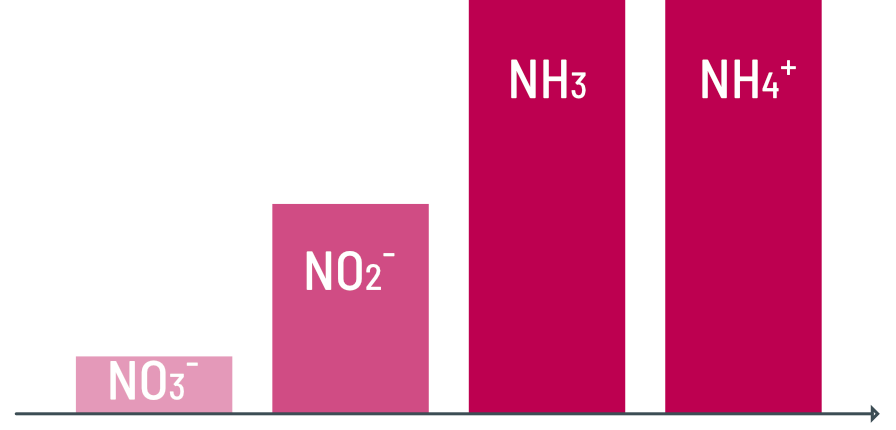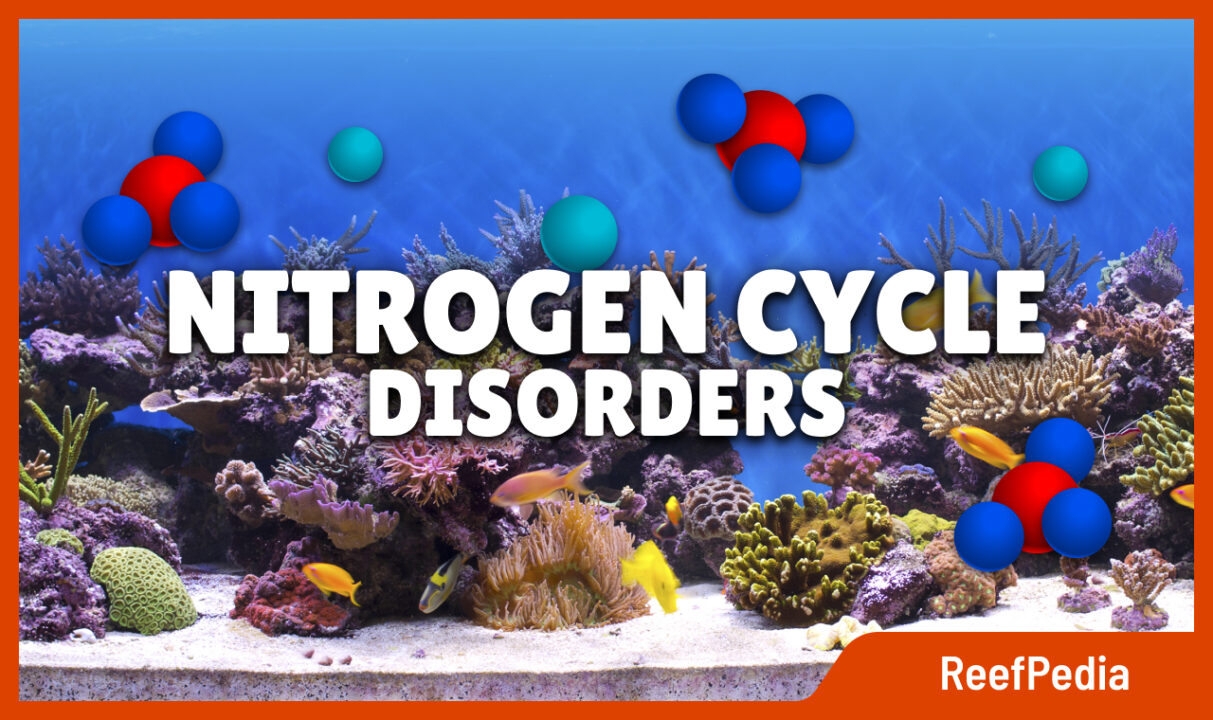Table of Contents
What is the nitrogen cycle
In a quick overview, the nitrogen cycle in marine aquariums refers to the biological process where nitrogen is transformed and cyclically converted into various forms by living organisms. The nitrogen cycle is extremely important as it helps maintain proper water parameters, such as the concentration of ammonia, nitrites, and other substances toxic to organisms. Controlling the nitrogen cycle is crucial for the health of animals in the aquarium.
For more information about biological cycles in marine aquariums, you can read dedicated articles on the nitrogen cycle and the phosphorus cycle. In this article, you will find more details about how water chemistry affects disruptions in the nitrogen cycle.
The role of the nitrogen cycle
In marine aquariums, the nitrogen cycle is crucial for maintaining a healthy and stable biological balance in the tank. Nitrogen, as an element, is essential for organisms, contributing to the construction of amino acids, nucleic acids (RNA and DNA), as well as ATP and NAD/NADP. This makes it important for reef care.
It’s important to note that the nitrogen cycle is not a one-time process that ends and is forgotten; nitrogen transformations in the aquarium occur continuously. The nitrogen cycle also helps prevent the accumulation of toxic substances in the water, which can lead to diseases and even the death of fish and other marine organisms. Therefore, when starting a marine aquarium, it is crucial to monitor the presence of harmful chemical compounds, such as ammonia, and not rush to introduce animals into the aquarium.
Causes of nitrogen cycle disorders
There are many reasons that can disturb the nitrogen cycle, the most important of which include:
- Overfeeding animals – if too much fish food is added to the aquarium, nitrifying bacteria may not be able to process all the excess nitrogen.
- Mechanical and biological filtration – improperly constructed aquariums and poorly set circulation can lead to the accumulation of pollutants, thereby disrupting the nitrification process.
- Incorrect aquarium maintenance – during the cleaning processes of a marine aquarium, beneficial nitrifying bacteria can be removed.
- Number of animals in the tank – both an excess and a lack of them.
- Improper water chemistry management.
The influence of water chemistry on nitrogen cycle disorders
In the further part of the article, I will focus on water chemistry, with particular emphasis on its impact on disturbances in the nitrogen cycle. Why? Primarily because water chemistry directly affects the proper functioning of the nitrogen cycle and serves many important functions:
- It serves as a carrier for nitrogen compounds, such as nitrates (NO3– ) or ammonia (NH3).
- It dissolves nitrogen compounds.
- It is essential for many chemical reactions occurring in the nitrogen cycle (denitrification, nitrification, and ammonification).
- It helps maintain the proper pH.
The impact of chemistry on the nitrogen cycle cannot be underestimated. Understanding the relationship between chemistry and the nitrogen cycle will help you prevent disruptions to the nitrogen cycle and, in turn, protect your aquarium and its inhabitants.
Main causes of nitrogen cycle disorders (water chemistry)
Changing seawater, the so-called water change
Both too frequent water changes and the absence of water changes can lead to disruptions in the nitrogen cycle.
However, two scenarios should be taken into account:
- Biologically immature aquarium
- Biologically mature aquarium
In the first case, we are talking about so-called “cycling” aquariums, usually less than 3 months old. Such an aquarium does not yet have established biological stability. That’s why water changes are not recommended when starting the aquarium, as they can prolong the maturation period of the marine aquarium.
In the second case, regular seawater changes are recommended to remove excess nitrogen and other pollutants from the aquarium.
Use of inappropriate chemical products
On the market, there are chemical preparations that can inhibit the activity of nitrifying bacteria. Incorrect use of these products can disrupt the nitrogen cycle, primarily by negatively affecting the bacteria.
Salinity level
The denitrification process usually decreases as salinity increases
SALINITY ↑↓ DENITRIFICATION PROCESS
Research has shown that nitrifying bacteria in environments with high salinity levels experience increased osmotic pressure. This means that nitrifying bacteria must consume more energy to maintain the proper salt concentration in their cells. As a result, there is less available energy for the nitrification process.
Another reason for slowing down the nitrification process in higher salinity is that elevated salinity can limit the availability of nutrients. These nutrients are essential for nitrifying organisms.
Incorrect water pH and carbonate hardness (dKH)
Incorrect pH and water hardness in seawater can significantly affect disruptions in the nitrogen cycle.
Many enzymes involved in various stages of the nitrogen cycle function optimally within specific pH ranges.
- Low pH negatively affects the activity of enzymes catalyzing (accelerating) nitrogen reactions in seawater.
- High carbonate hardness in seawater can cause the binding of nitrate ions with calcium or magnesium ions, hindering their conversion into forms more accessible to organisms.
Presence of trace elements
There are scientific studies that have shown a significant impact of trace elements on the nitrogen cycle. Trace elements, such as:
- Iron (Fe)
- Copper (Cu)
- Manganese (Mn)
- Molybdenum (Mo)
- Zinc (Zn)
- and many others
play an important role in the nitrogen cycle.
Iron: Iron plays a crucial role in the synthesis of chlorophyll, which is essential for photosynthesis.
Copper: Copper is necessary for the functioning of many enzymes involved in nitrogen metabolism. It helps convert ammonia into organic compounds and participates in the process of amino acid formation.
Manganese: Manganese is a key component of many enzymes involved in nitrogen transformation.
Molybdenum: Molybdenum is essential for the functioning of the nitrogenase enzyme, which catalyzes the reduction of atmospheric nitrogen to ammonia.
Zinc: Zinc is involved in nitrogen metabolism processes, such as protein synthesis. It is also engaged in the conversion of nitrates into organic forms.
Redox reactions
Chemical processes such as oxidation and reduction (redox reactions) also play an important role in regulating the nitrogen cycle in water. These processes impact the nitrogen cycle by transforming, for example, ammonia into safer forms of nitrogen. This is a redox reaction because nitrogen is oxidized, and oxygen is reduced. In this case, these reactions are often associated with bacteria.
For instance (1), the nitrogen cycle in marine aquariums may also involve the denitrification process, where nitrates are converted back into gaseous nitrogen (N2). Denitrifying bacteria, such as Pseudomonas and Paracoccus, carry out this reaction. Denitrification is also a redox reaction as nitrates are reduced to gaseous nitrogen.
(1) NO3 → N2
Effects of nitrogen cycle disorders
The continuous transformations of nitrogen in the aquarium are not a problem when the system is stable. However, in the case of disruptions to this cycle, we need to be aware that nitrogen is converted into various forms, and some of these forms are toxic to marine organisms. Ammonia (NH3) and ammonium ions (NH4+) exhibit the greatest harm, while nitrites (NO2–) are somewhat less harmful. Nitrates (NO3–) are harmful only at elevated levels:

Harmful to marine organisms.
excess NO3– :
- A sharp increase in the algae population
- Oxygen deficiency – nitrifying bacteria use more oxygen for the transformation of nitrogen compounds.
excess NH3 i NH4+ NO2– :
- Toxic effect on marine animals
Summary
Remember that the nitrogen cycle is constantly occurring in a marine aquarium, and any disruptions to it can have serious consequences for marine animals. Water chemistry plays a key role in the nitrogen cycle – which plays an important role in marine aquariums.
About author

Magdalena Metzler
Privately, I am a mother and a lover of nature and sport. My main interest is quantum chemistry, which hides a whole lot of unsolved mysteries and connections, which is extremely exciting from a scientific point of view.
In my scientific career, I have conducted international projects focused on innovative solutions for many branches of business, e.g. automotive, construction, and now, of course, marine aquaristics.
Working at Reef Factory gave me a passion for marine aquaristics, which I can develop every day, building a chemistry department and creating products that will help aquarists take care of tanks and ensure the highest safety of animals. One of the most exciting memories of working at Reef Factory is the commissioning of the ICP-OES spectrometer, which analyzes the elemental composition of seawater. The method of analysis in ICP is based on an analytical technique, which is a combination of my passion for quantum chemistry and marine aquaristics.
I hope you find my articles on ReefPedia interesting and helpful! Happy reading :))

